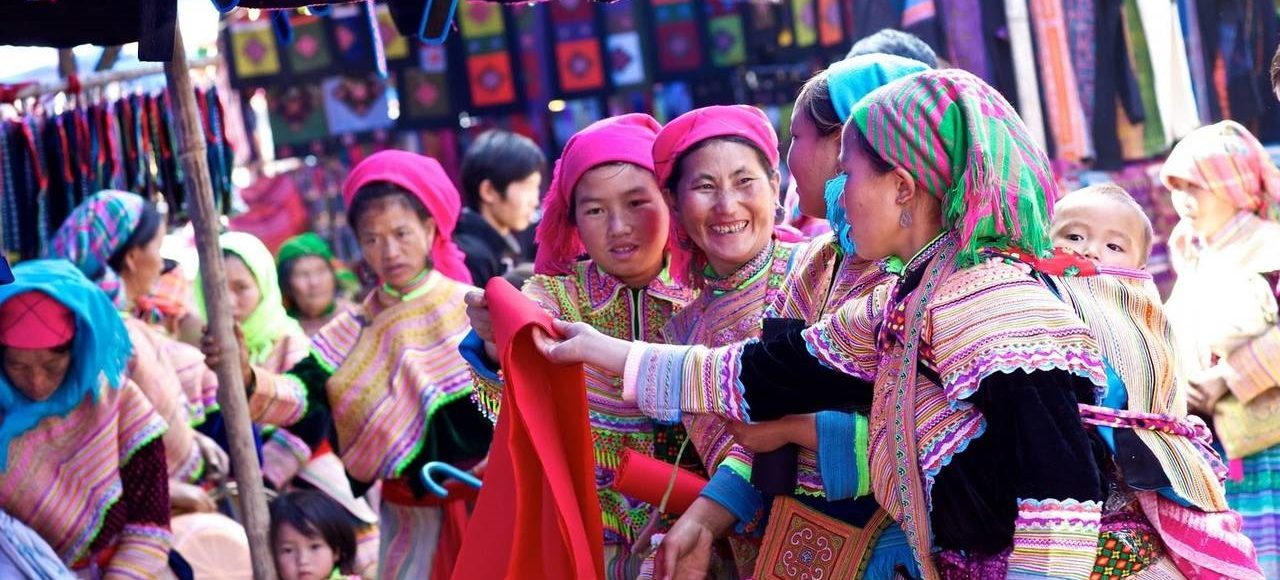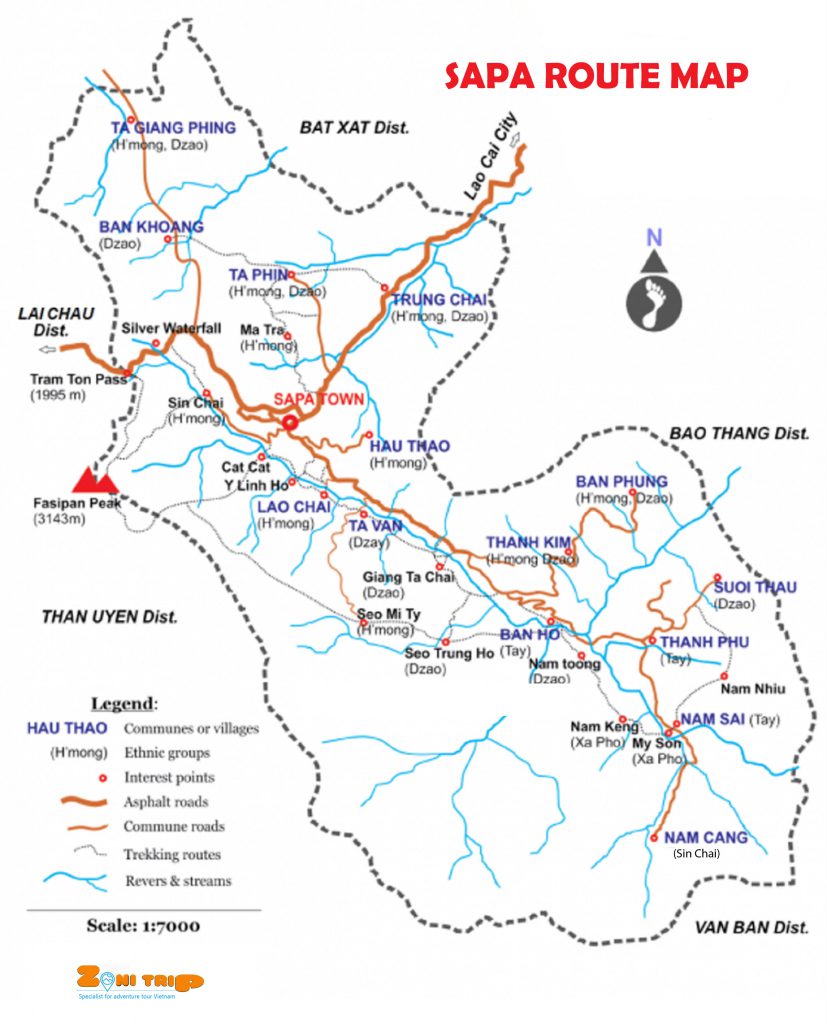Do not hesitate to give us a call. We are an expert team and we are happy to talk to you.
+84 389.927.861
info@zonitrip.com

Sapa is located in far Northwest Vietnam. It’s well-known as the best beautiful Rice Terrace in Vietnam & in the world. Bac Ha Market is also well known as one of the liveliest local markets in the Sapa area.
If you like photography, nature and people’s culture, mix with a little challenging via hiking local trails, this Sapa – Bac Ha Market Hiking tour 3 days tour is designed for you.
You have an opportunity to explore one of the most beautiful parts in the Sapa area, which is Muong Hoa valley to Ban Ho valley, which belong to the beautiful stream and rice terraces fields. Visiting the markets, your senses will be overwhelmed by sights, sounds and smells coming from the maze of stalls.
You will spend 2 nights in the homestay of tribal minority, to experience the local life and their culture. You will also be able to meet several different minorities, which cannot be found in other areas of Sapa, such as Black Hmong, Giay in Muong Hoa valley, Tay, Dao and Xa Pho in Ban Ho valley, Phu La, and Nung ethnic minorities at the prime time of lively Bac Ha market.
Our program has well organized and flexible for everyone, so let tell your need, we will tailor the hiking route, difficulty base on the layout program.
Noi Bai International Airport (Google Map)
Your hotel in Hanoi
An English speaking guide will collect you from your hotel in Hanoi at 21:00 and take you to Hanoi Train Station for the overnight train to Lao Cai.
The train arrives at around 6:00 am. Look for the “Trekking Sapa’s Logo & Your Name” sign when you exit the train station, as our guide will pick you up there and transfer from Lao Cai to Bac Ha market to soak in the vibrant atmosphere of the Bac Ha Sunday Markets – the largest in the region.
Observe the mix of Flower H’mong, Phu La, Black Dao, Tay and Nung ethnic minority traders that journey to the market from the surrounding mountainous areas. Browse the colorful stalls stocking a variety of local products, brightly colored handicrafts and fresh tea. You will join local ethnic peoples of the morning to enjoy the exciting atmosphere as well as activities of this market. Have lunch at a local restaurant.
After lunch, we will visit Hoang A Tuong’s palace, otherwise known as the outlandish Vua Meo. Constructed by the French in 1921 in an unusual ‘oriental baroque’ style, it resembles a hybrid between an exotic church and a French chateau, and was used to entertain the Flower H’mong chief Hoang A Tuong. Continue to visit Ban Pho Village before saying goodbye Bac Ha to Sapa. Arrive in Sapa, check in hotel and free time for relaxing or visiting local market.
Approx: 5 km of trekking
Enjoy your breakfast at the hotel, leave your luggage at the reception store.
At 9:00 am, we will leave Sapa and hike down to Cat Cat village, taking in the picturesque waterfall at the bottom of the hill. After a slight retrace of steps (but not all the way back up!) we will take a turn towards Y Linh Ho and begin a 2km walk through rice terraces. Y Linh Ho is home to the Hmong minority, and their hereditary rice terraces are around 100 years old. This is a perfect opportunity to immerse yourself in true Hmong culture!
From Y Linh Ho we will make our way to Lao Chai, an established Hmong minority village that has been inhabited for centuries. See the products of this minority at its best, with established rice terraces, homes and a vibrant community. You will be welcomed warmly by Mai and her family who run the first-ever homestay owned and run by Hmong minority in the Sapa region.
Summary:
When you awake on Day 3, open the window and have a look outside – weather permitting – you will be treated to amazing views across the rice terraces in the valley.
After breakfast, you will make your way to Ta Van where you will visit the Giay minority people. This tribe traditionally fished for a living and as a result, established themselves close to rivers. They have mastered the art of fishing with bamboo sticks, and cook the fish inside bamboo. Nowadays however you are more likely to see the Giay working in fields planting or harvesting rice. We will continue our walk through an impressive bamboo forest to Giang Ta Chai, and then on to the village of Su Pan where you will be able to rest your legs and take in the stunning mountain scenery as we stop for a picnic lunch.
After lunch,we will drive back to Sapa, arriving at around 3 pm with a great sense of achievement!
Upon arrive in Sapa, we take shower and spend the rest of the day exploring Sapa town with a market, square and abandoned church. Pack your things up, take some last flashing views of the charming, quiet town, at 5.30 pm we will be transferred to Lao Cai for the night train back to Hanoi.
Night 3: Overnight on the train (soft sleeper). You will arrive at Hanoi at 6am the next morning. Finish the Sapa Hiking trip 3 days.

Solo travel is taking off. More and more adventurers are forging their own path and travelling alone as part of a group tour. And it’s no wonder. With the confidence you gain from seeing the world on your terms, solo travel gives you a sense of freedom like nothing else.
If you want to travel to your own tune, you’ll be in good company with Zonitrip. Lots of our travellers arrive alone and leave with lifelong friends. With shared authentic experiences in far-flung destinations, our tours are the perfect chance to create lasting friendships.
We’ll match you with the group having suit your departure time, so you can share the tour cost. About single supplements like accommodation, most of our homestay have a single mattress so it’s very convenient for solo travel. If you want to upgrade a private room, the small surcharge can be accepted.
If at the departure time you want, we haven’t had any other group, you can book in advance or deposit to keep a sit. We will inform you of the update or customized suitable or better options.
You can also find many travel ideas and tours here in the best solo travel destinations. Don’t worry, let contact with us.
Email: info@zonitrip.com
Tel/whatsapp: +84389927861
After a long day with a lot of activities, we know a comfortable place to rest overnight is a special concern. A relaxed and enjoyable accommodation is not only to state the quality of the tour but also to get the energy back for the possibly hard days after.
However, the Trekking and Motorbike tours of Zonitrip are almost at remote regions where accommodations are not like other big towns, so we’ll stay mostly at the standard hotels or home-stay. But don’t’ worry, they’re surely safe and the equipment is comfortable enough for you:
Mostly 90% of Zonitrip’s customers are pleased with staying at homestays.
All the families we choose to stay have special permits and are certificated from the local government. Most of the homestays are nice wood and clean houses on stilts, are owned by warmly host, who are local knowing well area. Below is the equipment you can expect to have at the homestay: private mats, blankets, mosquito nets, fans, clean toilets, hot water.
In Sapa, you will spend 1 night at a hotel. There are many choices, you can choose from 3-4-5star hotel.
If you have any specific inquiry about accommodation, don’t hesitate to discuss with us.
We would like to say the food on tours is one of the most important reasons to make our clients come back for more.
We serve almost local Vietnamese food on the tour. Generally, Vietnamese food is light but it’s surely not boring and so healthy. We can be sure all food is fresh with a lot of vegetables, especially for vegetarians.
We sometimes choose a basic roadside restaurant for meals or eating at the homestay but the food is always fresh, tasty and plenty to choose.
Such as famous PHO (rice noodle soup), BUN CHA (special noodle with grilled pork), NEM (Spring rolls)…The local people have different methods to cook so we can be sure you can have different food for each meal during the long adventure tours in Vietnam.
All our quotes are in USD/VND. We accept Visa/MasterCard by either directly giving us your card details or using our authorized payment form, Western Union, bank transfers or cash ( USD & VND).
Once you have agreed on an itinerary or service we will ask for a 30% deposit and start making reservations for you. Once all reservations have been made we will confirm back to you. The final balance is due on your arrival in our area or before your tour departs.
wonderful tour!”
“What is so beautiful about Bac Ha Market?” – that’s my first thought before the trip “Sapa Bac Ha Market”. After 3 nights and 2 days of amazingly wonderful tour where we got to the inner heart of this hill, met Black Hmong tribe and enjoyed tasty meals, I understand why this place is famous. The experience could not be this memorable without the helpful tour guides. They made everything easy for us to join in. The stay, the activities, the gifts – all are awesome. I’m surely be back with you guys in the future.
Sapa Tours from Hanoi 3 days”
I could not thank Nghĩa enough for making this trip one of the most memorable experiences. My mum and I decided we wanted to do a trek in Sapa and we could not have been more lucky to come across Zonitrips website. Throughout the 4 days Nghĩa provided a real life taste of living among the locals, with great home stays, amazing food and unforgettable views. This incredible experience was only complimented by Nghĩa’s warm, friendly and considerate nature, and I feel lucky to now be able to call her a friend. I would 100% recommend anyone to take a trip with Zonitrip, you
will definitely not regret it, making memories that will last a lifetime!